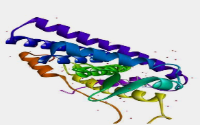In Silico Analysis of Isoflavone Compounds in Soybean (Glycine max L) as Anti-Breast Cancer Agents Targeting Estrogen Receptor Alpha
Main Article Content
Abstract
Breast cancer is a main health concern globally and the second leading cause of cancer death in many countries, including developed and developing. Meanwhile, soybean is reported to contain isoflavones, which have properties similar to certain hormonal anti-cancer drugs. This study aimed to investigate the anti-breast cancer activity of isoflavone compounds in soybean (Glycine max L) against estrogen receptor alpha. In Silico test was conducted on isoflavone compounds in soybean, which consisted of 12 isoforms including Daidzein, Daidzin, Genistein, Glycitein, Genistin, Glycitin, Acetyl Daidzin, Acetyl Genistin, Acetyl glycitin, Malonyl Daidzin, Malonyl Genistin, and Malonyl Glycitin. The results showed that four compounds passed the Lipinski's rule test and achieved strong binding affinity namely Daidzein, Genistein, Glycitein, and Acetyl Daidzin with values of -8.47, -8.5, -8.6, and -7.09 respectively. These compounds also formed hydrogen bonds in the interactions with macromolecules. Specifically, Daidzein, Glycitein, and Acetyl Daidzin formed three hydrogen bonds each, while Genistein formed five hydrogen bonds. Based on the results, soybean has anti-breast cancer activity as shown by In Silico test on the estrogen receptor alpha.
Metrics
Article Details

This work is licensed under a Creative Commons Attribution-NonCommercial 4.0 International License.
References
Aher, Rahul B.; Roy, Kunal. Computational approaches as rational decision support systems for discovering next-generation antitubercular agents: mini-review. Curr Comput-Aid Drug, 2019, 15.5: 369-383.
Ahmad, Aamir. Breast cancer statistics: recent trends. Breast cancer metastasis and drug resistance: challenges and progress, 2019, 1-7.
Amiri, Ali, et al. Chemotherapy‐induced toxicity in patients with testicular germ cell tumors: The impact of physical fitness and regular exercise. Andrology, 2021, 9.6: 1879-1892.
Cai, Xia, et al. Phytoestrogens for the management of endometriosis: Findings and issues. Pharmaceuticals, 2021, 14.6: 569.
Chakraborty, Binita, et al. Estrogen receptor signaling in the immune system. Endocr. Rev, 2023, 44.1: 117-141.
Chhikara, Bhupender S., et al. Global Cancer Statistics 2022: the trends projection analysis. Chem. Biol. Lett. 2023, 10.1: 451-451.
De Luca, Caterina, et al. Metastatic Breast Neuroendocrine Cancer in Pregnancy: A Case of an Oncologic Emergency and a Review of Literature. MFM, 2020, 2.04: 248-252.
De Ruysscher, Dirk, et al. Radiotherapy toxicity. Nature Reviews Disease Primers, 2019, 5.1: 13.
Ferlay, Jacques, et al. Cancer statistics for the year 2020: An overview. Int J Cancer, 2021, 149.4: 778-789.
Fuentes, Nathalie; SILVEYRA, Patricia. Estrogen receptor signaling mechanisms. Advances in protein chemistry and structural biology, 2019, 116: 135-170.
Ghiandoni, Gian Marco; Caldeweyher, Eike. Fast calculation of hydrogen-bond strengths and free energy of hydration of small molecules. Sci Rep, 2023, 13.1: 4143.
Grabowski, Sławomir J., et al. Quantitative classification of covalent and noncovalent H-bonds. J. Phys. Chem. B, 2006, 110.13: 6444-6446.
Harris, Thomas K.; Mildvan, Albert S. High‐precision measurement of hydrogen bond lengths in proteins by nuclear magnetic resonance methods. Proteins: Structure, Function, and Bioinformatics, 1999, 35.3: 275-282.
Hassan Baig, Mohammad, et al. Computer aided drug design: success and limitations. Current pharmaceutical design, 2016, 22.5: 572-581.
Hossain, Shakhawath, et al. Molecular simulation as a computational pharmaceutics tool to predict drug solubility, solubilization processes and
partitioning. Eur J Pharm Biopharm, 2019, 137: 46-55.
Hugas, D., et al. Delocalization indices for non-covalent interaction: Hydrogen and DiHydrogen bond. Comput Theor Chem, 2012, 998: 113-119.
Jamkhande, Prasad G.; Ghante, Mahavir H.; Ajgunde, Balaji R. Software based approaches for drug designing and development: A systematic review on commonly used software and its applications. Bulletin of Faculty of Pharmacy, Cairo University, 2017, 55.2: 203-210.
Jia, Min; Dahlman-wright, Karin; Gustafsson, Jan-Åke. Estrogen receptor alpha and beta in health and disease. Best practice & research Clinical endocrinology & metabolism, 2015, 29.4: 557-568.
Kamath, Venkatesh; Pai, Aravinda. Application of molecular descriptors in modern computational drug design-an overview. Res J Pharm Technol, 2017, 10.9: 3237-3241.
Karas, Lucas J., et al. Hydrogen bond design principles. Wiley Interdiscip Rev Comput Mol Sci, 2020, 10.6: e1477.
Leclercq, Guy; Jacquot, Yves. Interactions of isoflavones and other plant derived estrogens with estrogen receptors for prevention and treatment of breast cancer—considerations concerning related efficacy and safety. J. Steroid Biochem. Mol. Biol, 2014, 139: 237-244.
Mora, Dana C., et al. Complementary and alternative medicine modalities used to treat adverse effects of anti-cancer treatment among children and young adults: a systematic review and meta-analysis of randomized controlled trials. BMC Complementary Medicine and Therapies, 2022, 22.1: 97.
Patel, Jimish R., et al. A review on computational software tools for drug design and discovery. Indo Global J. Pharm. Sci, 2022, 12: 53-81.
Sahoo, R. N., et al. Review on the use of Molecular Docking as the First Line Tool in Drug Discovery and Development. Indian J. Pharm. Sci, 2022, 84.5.
Sridevi, Vaadala, et al. Beneficiary and adverse effects of phytoestrogens: A potential constituent of plant-based diet. Current Pharmaceutical Design, 2021, 27.6: 802-815.
Suetsugi, Masatomo, et al. Flavone and isoflavone phytoestrogens are agonists of estrogen-related receptors. Mol Cancer Res, 2003, 1.13: 981-991.
Sun, Hongna, et al. Primary neuroendocrine tumor of the breast: current understanding and future perspectives. Frontiers in Oncology, 2022, 12: 848485.
Tecalco-cruz, Angeles C.; Ramírez-jarquín, Josué O.; Cruz-ramos, Eduardo. Estrogen receptor alpha and its ubiquitination in breast cancer cells. Current drug targets, 2019, 20.6: 690-704.
Tian, Qi, et al. The efficacy of virtual reality–based interventions in breast cancer–related symptom management: A systematic review and meta-analysis. Cancer nursing, 2023, 46.5: E276-E287.
Torrens-mas, Margalida; ROCA, Pilar. Phytoestrogens for cancer prevention and treatment. Biology, 2020, 9.12: 427.
Trott, O.; Olson, A. Software news and update AutoDock Vina: Improving the speed and accuracy of docking with a new scoring function. Effic. Optim. Multithreading, 2009, 31: 455-461.
Yu, Kun, et al. Estrogen receptor function: impact on the human endometrium. Frontiers in endocrinology, 2022, 13: 827724.
Yunta, María JR. It is important to compute intramolecular hydrogen bonding in drug design. Am. J. Model. Optim, 2017, 5.1: 24-57.


